ECO mode TOYOTA SEQUOIA 2016 2.G Quick Reference Guide
[x] Cancel search | Manufacturer: TOYOTA, Model Year: 2016, Model line: SEQUOIA, Model: TOYOTA SEQUOIA 2016 2.GPages: 52, PDF Size: 4.88 MB
Page 8 of 52
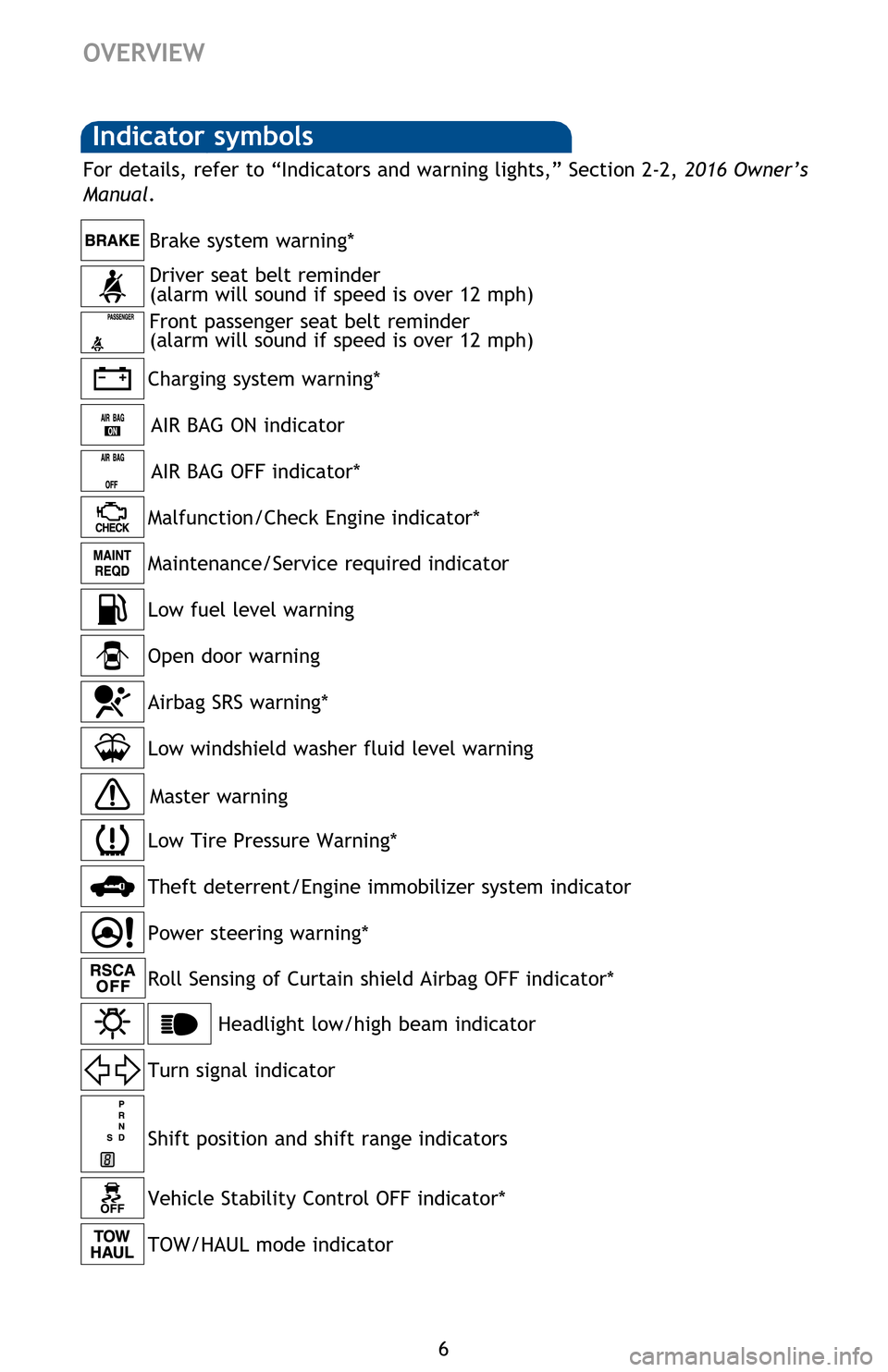
6
Indicator symbols
Charging system warning*Brake system warning*
AIR BAG ON indicator
Driver seat belt reminder
(alarm will sound if speed is over 12 mph)
Front passenger seat belt reminder
(alarm will sound if speed is over 12 mph)
AIR BAG OFF indicator*
For details, refer to “Indicators and warning lights,” Section 2-2, 2016 Owner’s
Manual .
Headlight low/high beam indicator
Turn signal indicator
Low Tire Pressure Warning *
Power steering warning*
Open door warning
Airbag SRS warning*
Master warning
Theft deterrent/Engine immobilizer system indicator Malfunction/Check Engine indicator*
Maintenance/Service required indicator
Low fuel level warning
Roll Sensing of Curtain shield Airbag OFF indicator *
Shift position and shift range indicators
Vehicle Stability Control OFF indicator*
TOW/HAUL mode indicator
Low windshield washer fluid level warning
OVERVIEW
* If indicator does not turn off within a few seconds of starting engine, there may be a
malfunction. Have vehicle inspected by your Toyota dealer.
2016_Sequoia_QRG.r2.indd 67/10/15 4:48 PM
Page 12 of 52
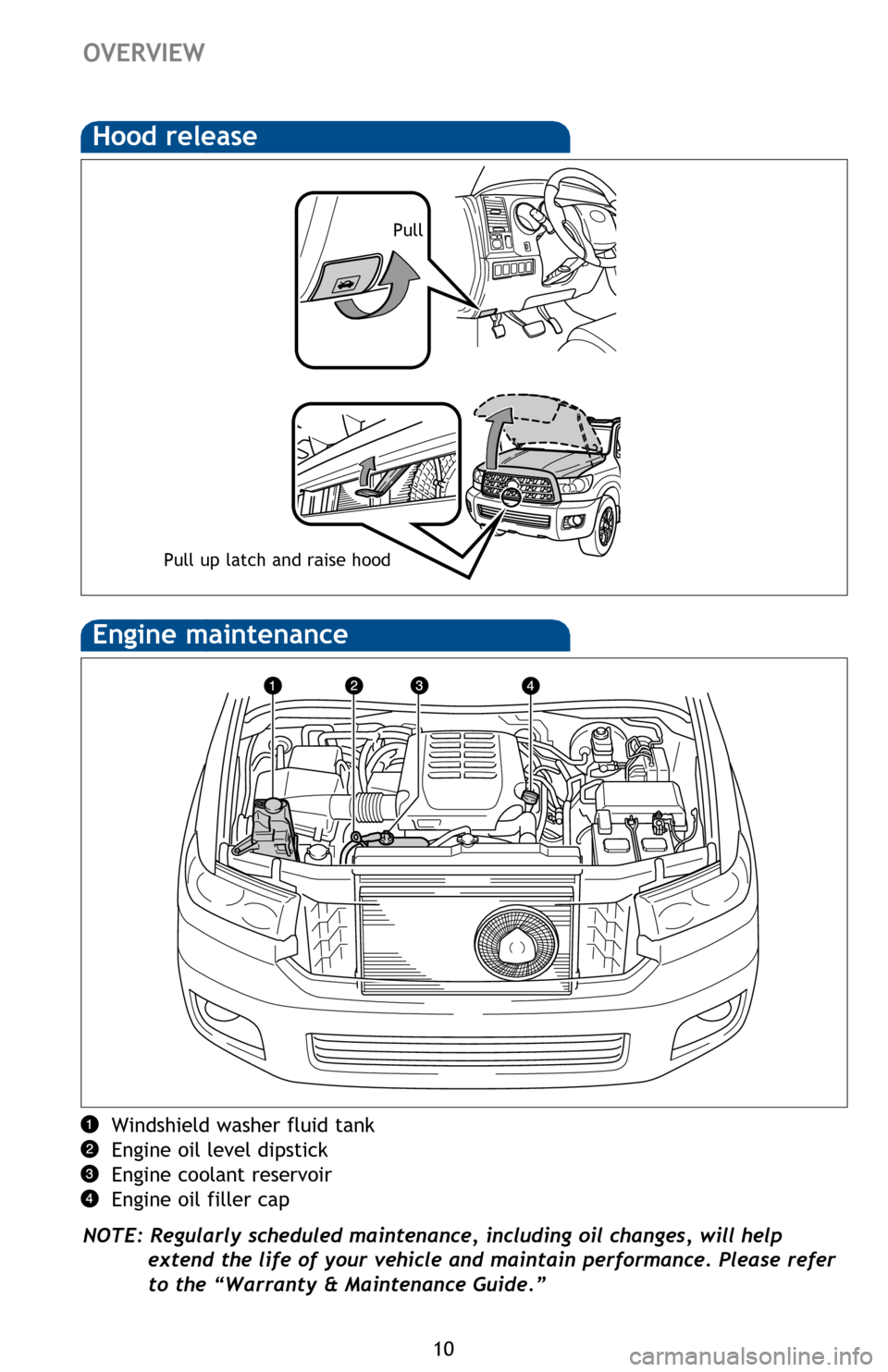
10
Windshield washer fluid tank
Engine oil level dipstick
Engine coolant reservoir
Engine oil filler cap
NOTE: Regularly scheduled maintenance, including oil changes, will help extend the life of your vehicle and maintain performance. Please refer
to the “Warranty & Maintenance Guide.”
Engine maintenance
OVERVIEWFEATURES/OPERATIONS
Automatic Transmission
* The ignition switch must be “ON” and the brake pedal depressed t\
o shift from Park.
Shift the shift lever to “S” position from “D” position.
+: Upshift (push and release)
-: Downshift (pull and release)
Downshifting increases power going uphill, or provides engine braking downhill.
For best fuel economy during normal driving conditions, always drive with the
shift lever in the “D” position.
“S” (Sequential) mode
TOW/HAUL switch (if equipped)
“TOW/HAUL” mode can be used when carrying heavy loads. As fuel economy is
reduced while in “TOW/HAUL” mode, deactivating when driving without a load is
recommended.
Refer to the Owner‘s Manual for more details on this system before attempting
to use it.
Hood release
Pull up latch and raise hood
Pull
Auto lock/unlock
Automatic door locks can be programmed to operate in four different modes, or
turned OFF.
-Doors lock when shifting from Park.
-Doors lock when the vehicle speed is approximately 12 mph or higher.
-Doors unlock when shifting into Park.
-Doors unlock when the driver’s door is opened within 10 seconds after turning the ignition switch to the “ACC” or “LOCK” position.
Refer to the Owner’s Manual for more details.
2016_Sequoia_QRG.indd 107/6/15 8:10 PM
Page 13 of 52
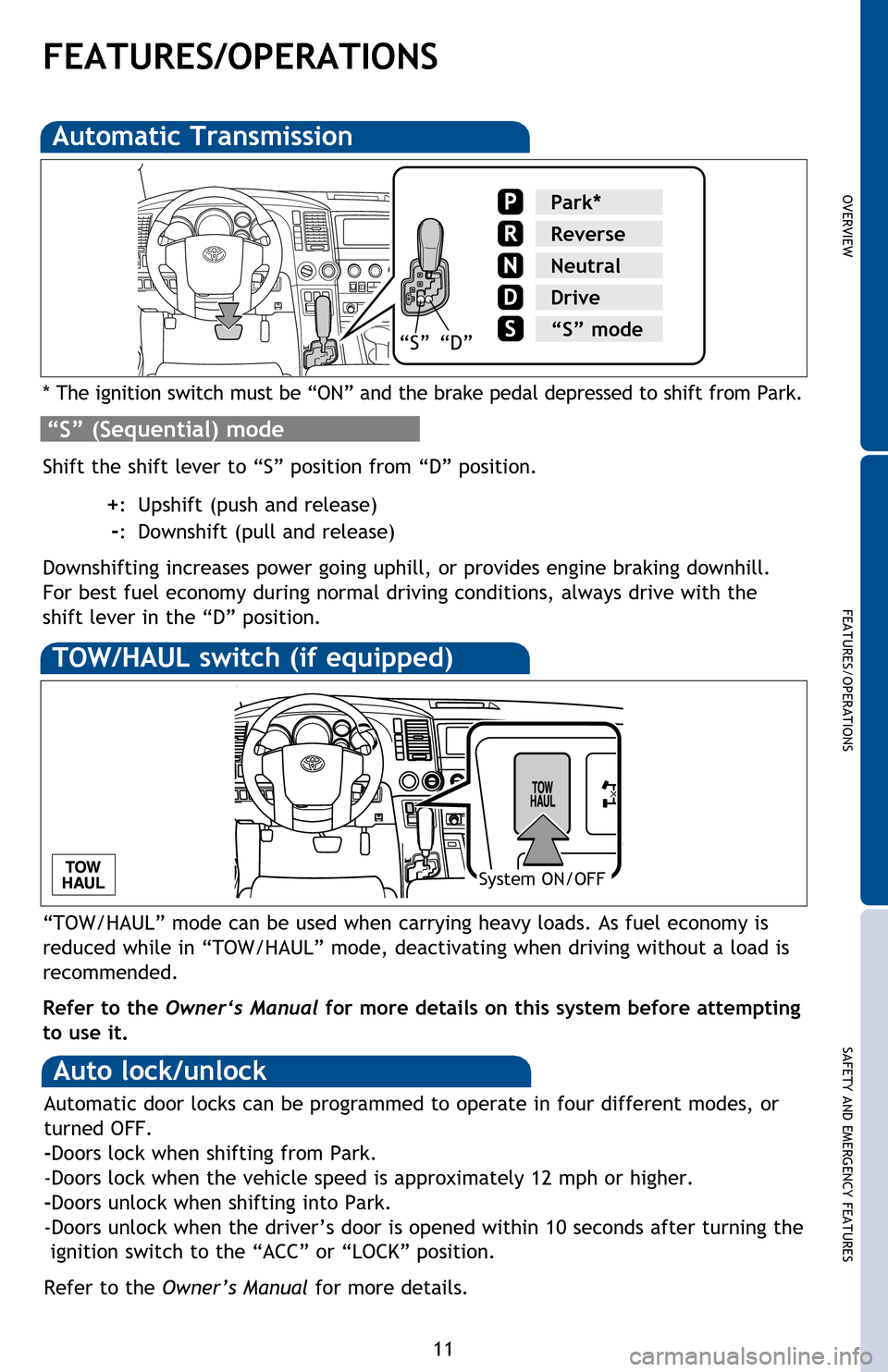
OVERVIEW
FEATURES/OPERATIONS
SAFETY AND EMERGENCY FEATURES
11
Windshield washer fluid tank
Engine oil level dipstick
Engine coolant reservoir
Engine oil filler cap
NOTE: Regularly scheduled maintenance, including oil changes, will help extend the life of your vehicle and maintain performance. Please refer
to the “Warranty & Maintenance Guide.”
FEATURES/OPERATIONS
Automatic Transmission
* The ignition switch must be “ON” and the brake pedal depressed t\
o shift from Park.
Shift the shift lever to “S” position from “D” position.
+: Upshift (push and release)
-: Downshift (pull and release)
Downshifting increases power going uphill, or provides engine braking downhill.
For best fuel economy during normal driving conditions, always drive with the
shift lever in the “D” position.
“S” (Sequential) mode
Park*
Reverse
Neutral
Drive
“S” mode“S”“D”
TOW/HAUL switch (if equipped)
“TOW/HAUL” mode can be used when carrying heavy loads. As fuel economy is
reduced while in “TOW/HAUL” mode, deactivating when driving without a load is
recommended.
Refer to the Owner‘s Manual for more details on this system before attempting
to use it.
System ON/OFF
Auto lock/unlock
Automatic door locks can be programmed to operate in four different modes, or
turned OFF.
-Doors lock when shifting from Park.
-Doors lock when the vehicle speed is approximately 12 mph or higher.
-Doors unlock when shifting into Park.
-Doors unlock when the driver’s door is opened within 10 seconds after turning the ignition switch to the “ACC” or “LOCK” position.
Refer to the Owner’s Manual for more details.
2016_Sequoia_QRG.indd 117/6/15 8:10 PM
Page 15 of 52
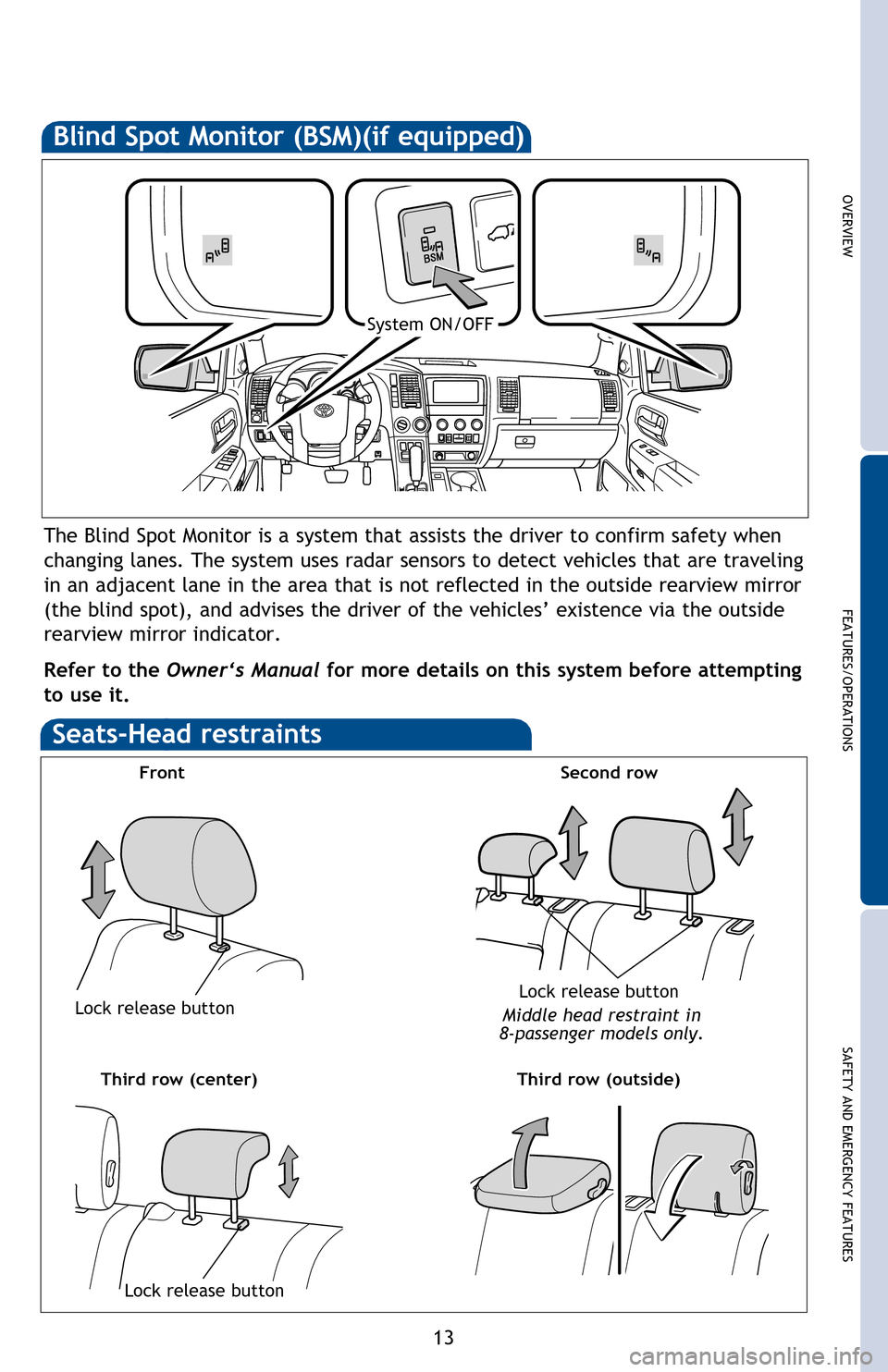
OVERVIEW
FEATURES/OPERATIONS
SAFETY AND EMERGENCY FEATURES
13
Lock the center differential if the vehicle’s wheels get stuck in a ditch or when
driving on a slippery or bumpy surface.
Refer to the Owner‘s Manual for more details on this system before attempting
to use it.
High speed (2WD)
Turn to “2WD” from “4H” with speed below 62 mph.
High speed (4WD)
Turn to “4H” from “2WD” with speed below 62 mph.
Shift to “N” position when stopped, then turn to “4H” from “4L.”
Low speed (4WD)
Shift to “N” position when stopped, then push and turn to “4L”\
from “4H.”
For best fuel economy and performance under normal driving conditions, keep in
“2WD” position.
Blind Spot Monitor (BSM)(if equipped)
The Blind Spot Monitor is a system that assists the driver to confirm safety when
changing lanes. The system uses radar sensors to detect vehicles that are traveling
in an adjacent lane in the area that is not reflected in the outside rearview mirror
(the blind spot), and advises the driver of the vehicles’ existence via the outside
rearview mirror indicator.
Refer to the Owner‘s Manual for more details on this system before attempting
to use it.
System ON/OFF
Set: Depress
Release: Depress again
Seats-Head restraints
Front
Third row (center)
Lock release button
Lock release button
Second row
Lock release button
Middle head restraint in
8-passenger models only.
Third row (outside)
2016_Sequoia_QRG.r2.indd 137/9/15 11:40 AM
Page 24 of 52
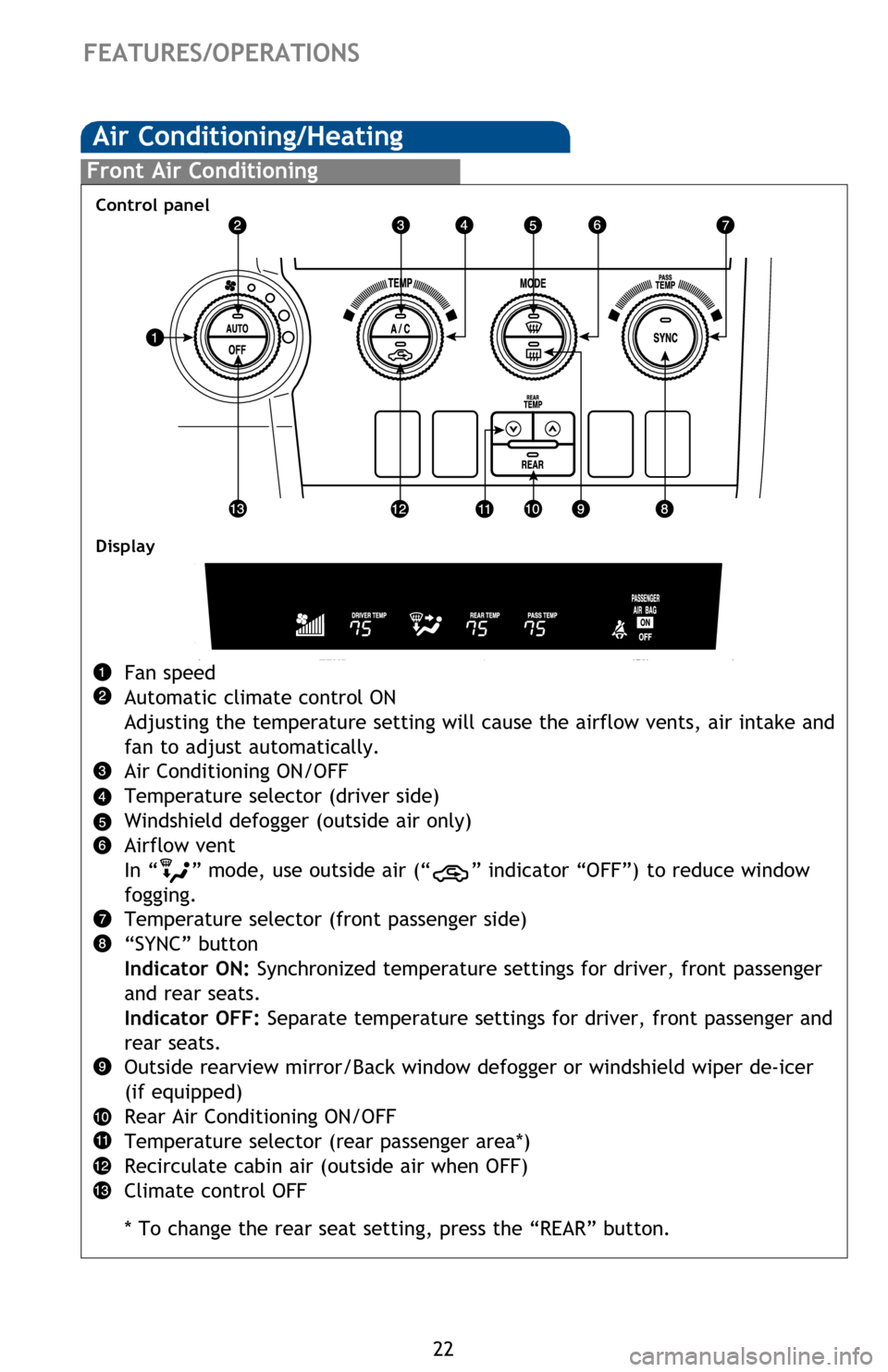
22
Front Air Conditioning
Fan speed
Automatic climate control ON
Adjusting the temperature setting will cause the airflow vents, air intake and
fan to adjust automatically.
Air Conditioning ON/OFF
Temperature selector (driver side)
Windshield defogger (outside air only)
Airflow vent
In “
” mode, use outside air (“” indicator “OFF”) to reduce window
fogging.
Temperature selector (front passenger side)
“SYNC” button
Indicator ON: Synchronized temperature settings for driver, front passenger
and rear seats.
Indicator OFF: Separate temperature settings for driver, front passenger and
rear seats.
Outside rearview mirror/Back window defogger or windshield wiper de-icer
(if equipped)
Rear Air Conditioning ON/OFF
Temperature selector (rear passenger area*)
Recirculate cabin air (outside air when OFF)
Climate control OFF
* To change the rear seat setting, press the “REAR” button.
FEATURES/OPERATIONS
Air Conditioning/HeatingRear Air Conditioning
Automatic climate control ON
Display
Airflow vent
Fan speed
Temperature selector
Climate control OFF
Seat ventilators/heaters (if equipped)
Front seats
Second seats
Driver’s seat
Ventilator
With ventilators
Control panel
Display
High heat
setting
Push lightly in the opposite direction to turn off.
2016_Sequoia_QRG.indd 227/6/15 8:10 PM
Page 25 of 52
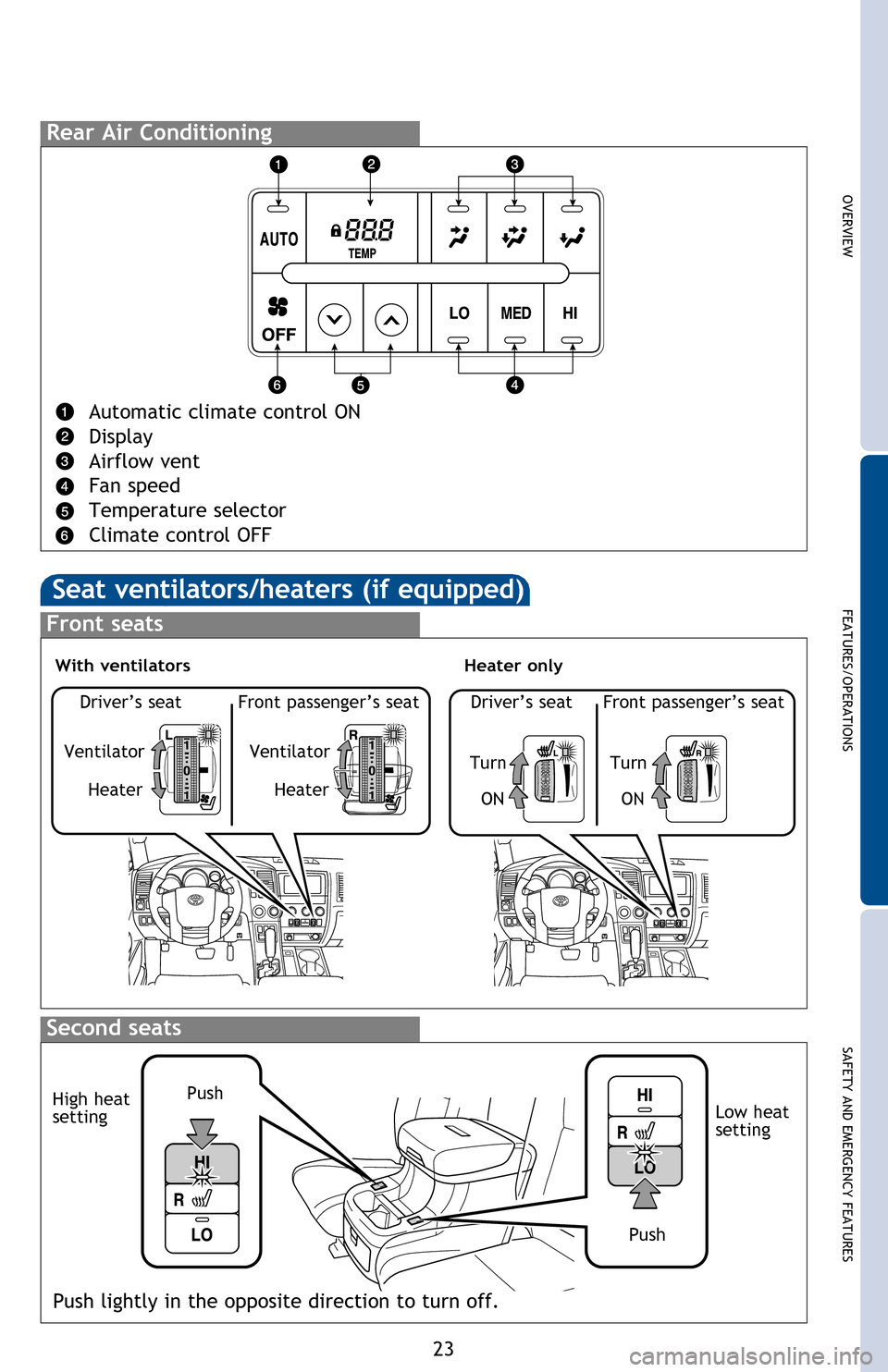
OVERVIEW
FEATURES/OPERATIONS
SAFETY AND EMERGENCY FEATURES
23
Fan speed
Automatic climate control ON
Adjusting the temperature setting will cause the airflow vents, air intake and
fan to adjust automatically.
Air Conditioning ON/OFF
Temperature selector (driver side)
Windshield defogger (outside air only)
Airflow vent
In “
” mode, use outside air (“” indicator “OFF”) to reduce window
fogging.
Temperature selector (front passenger side)
“SYNC” button
Indicator ON: Synchronized temperature settings for driver, front passenger
and rear seats.
Indicator OFF: Separate temperature settings for driver, front passenger and
rear seats.
Outside rearview mirror/Back window defogger or windshield wiper de-icer
(if equipped)
Rear Air Conditioning ON/OFF
Temperature selector (rear passenger area*)
Recirculate cabin air (outside air when OFF)
Climate control OFF
* To change the rear seat setting, press the “REAR” button.
Rear Air Conditioning
Automatic climate control ON
Display
Airflow vent
Fan speed
Temperature selector
Climate control OFF
Seat ventilators/heaters (if equipped)
Front seats
Second seats
Ventilator
Driver’s seat Front passenger’s seat
Heater
Ventilator
HeaterTurn
Driver’s seat Front passenger’s seat
ON
Turn
ON
Heater onlyWith ventilators
Push
Push
Low heat
setting
High heat
setting
Push lightly in the opposite direction to turn off.
2016_Sequoia_QRG.indd 237/6/15 8:10 PM
Page 36 of 52
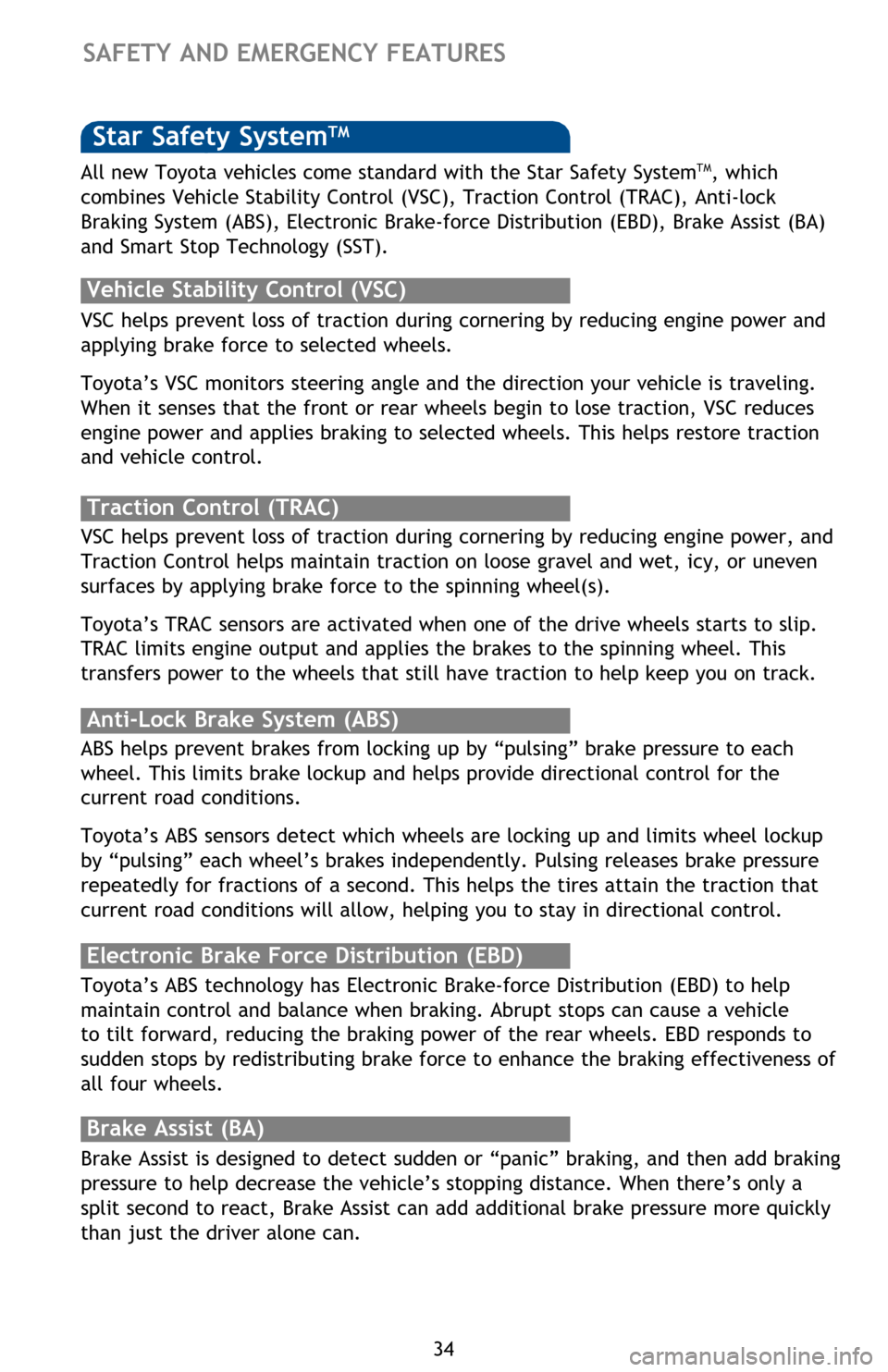
34
There are two types of Toyota floor mats: carpeted and all-weather. Each vehicle
has model-specific floor mats. Installation is easy.
To keep your floor mat properly positioned, follow these steps:
• Only use floor mats designed for your specific model.
• Use only one floor mat at a time, using the retaining hooks to keep the mat in
place.
• Install floor mats right side up.
Floor mat installation
SAFETY AND EMERGENCY FEATURES
Smart Stop Technology automatically reduces engine power when the accelerator
and brake pedals are pressed simultaneously under certain conditions.
SST engages when the accelerator is depressed first and the brakes are applied
firmly for longer than one-half second at speeds greater than five miles per hour.
SST doesn’t engage if the brake pedal is depressed before the accelerator pedal,
allowing vehicles to start on a steep hill and safely accelerate without rolling
backward.
Smart Stop Technology (SST)Star Safety SystemTM
VSC helps prevent loss of traction during cornering by reducing engine power and
applying brake force to selected wheels.
Toyota’s VSC monitors steering angle and the direction your vehicle is traveling.
When it senses that the front or rear wheels begin to lose traction, VSC reduces
engine power and applies braking to selected wheels. This helps restore traction
and vehicle control.
Vehicle Stability Control (VSC)
Anti-Lock Brake System (ABS)
ABS helps prevent brakes from locking up by “pulsing” brake pressure to each
wheel. This limits brake lockup and helps provide directional control for the
current road conditions.
Toyota’s ABS sensors detect which wheels are locking up and limits wheel lockup
by “pulsing” each wheel’s brakes independently. Pulsing releases brake pressure
repeatedly for fractions of a second. This helps the tires attain the traction that
current road conditions will allow, helping you to stay in directional control.
Brake Assist (BA)
Brake Assist is designed to detect sudden or “panic” braking, and then add braking
pressure to help decrease the vehicle’s stopping distance. When there’s only a
split second to react, Brake Assist can add additional brake pressure more quickly
than just the driver alone can. VSC helps prevent loss of traction during cornering by reducing engine power, and
Traction Control helps maintain traction on loose gravel and wet, icy, or uneven
surfaces by applying brake force to the spinning wheel(s).
Toyota’s TRAC sensors are activated when one of the drive wheels starts to slip.
TRAC limits engine output and applies the brakes to the spinning wheel. This
transfers power to the wheels that still have traction to help keep you on track.
Traction Control (TRAC)
Electronic Brake Force Distribution (EBD)
Toyota’s ABS technology has Electronic Brake-force Distribution (EBD) to help
maintain control and balance when braking. Abrupt stops can cause a vehicle
to tilt forward, reducing the braking power of the rear wheels. EBD responds to
sudden stops by redistributing brake force to enhance the braking effectiveness of
all four wheels. All new Toyota vehicles come standard with the Star Safety System
TM, which
combines Vehicle Stability Control (VSC), Traction Control (TRAC), Anti-lock
Braking System (ABS), Electronic Brake-force Distribution (EBD), Brake Assist (BA)
and Smart Stop Technology (SST).
2016_Sequoia_QRG.indd 347/6/15 8:11 PM
Page 37 of 52
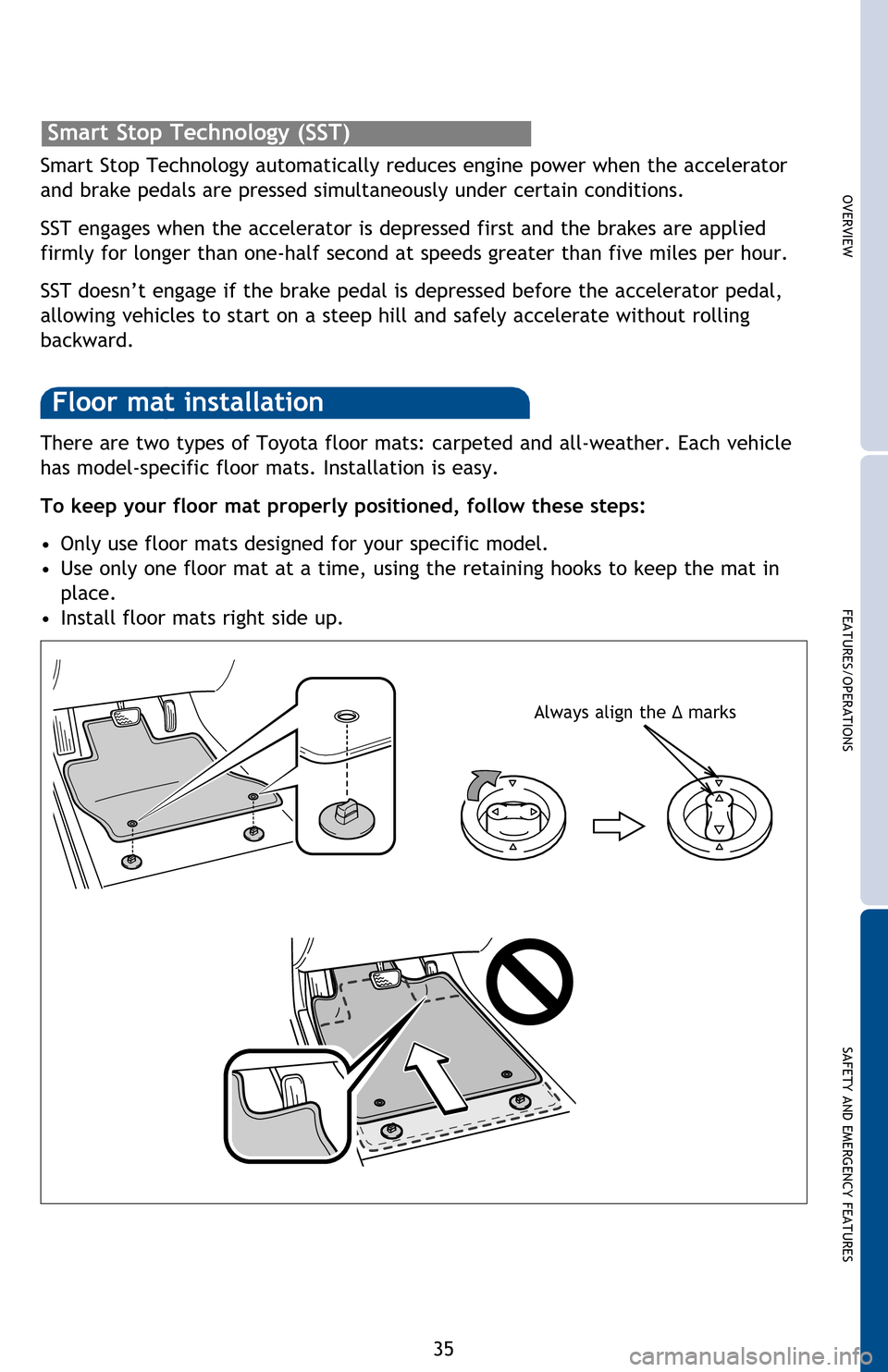
OVERVIEW
FEATURES/OPERATIONS
SAFETY AND EMERGENCY FEATURES
35
There are two types of Toyota floor mats: carpeted and all-weather. Each vehicle
has model-specific floor mats. Installation is easy.
To keep your floor mat properly positioned, follow these steps:
•
Only use floor mats designed for your specific model.
• Use only one floor mat at a time, using the retaining hooks to keep the mat in
place.
• Install floor mats right side up.
Floor mat installation
SAFETY AND EMERGENCY FEATURES
Smart Stop Technology automatically reduces engine power when the accelerator
and brake pedals are pressed simultaneously under certain conditions.
SST engages when the accelerator is depressed first and the brakes are applied
firmly for longer than one-half second at speeds greater than five miles per hour.
SST doesn’t engage if the brake pedal is depressed before the accelerator pedal,
allowing vehicles to start on a steep hill and safely accelerate without rolling
backward.
Smart Stop Technology (SST)
VSC helps prevent loss of traction during cornering by reducing engine power and
applying brake force to selected wheels.
Toyota’s VSC monitors steering angle and the direction your vehicle is traveling.
When it senses that the front or rear wheels begin to lose traction, VSC reduces
engine power and applies braking to selected wheels. This helps restore traction
and vehicle control.
ABS helps prevent brakes from locking up by “pulsing” brake pressure to each
wheel. This limits brake lockup and helps provide directional control for the
current road conditions.
Toyota’s ABS sensors detect which wheels are locking up and limits wheel lockup
by “pulsing” each wheel’s brakes independently. Pulsing releases brake pressure
repeatedly for fractions of a second. This helps the tires attain the traction that
current road conditions will allow, helping you to stay in directional control.
Brake Assist is designed to detect sudden or “panic” braking, and then add braking
pressure to help decrease the vehicle’s stopping distance. When there’s only a
split second to react, Brake Assist can add additional brake pressure more quickly
than just the driver alone can. VSC helps prevent loss of traction during cornering by reducing engine power, and
Traction Control helps maintain traction on loose gravel and wet, icy, or uneven
surfaces by applying brake force to the spinning wheel(s).
Toyota’s TRAC sensors are activated when one of the drive wheels starts to slip.
TRAC limits engine output and applies the brakes to the spinning wheel. This
transfers power to the wheels that still have traction to help keep you on track.
Toyota’s ABS technology has Electronic Brake-force Distribution (EBD) to help
maintain control and balance when braking. Abrupt stops can cause a vehicle
to tilt forward, reducing the braking power of the rear wheels. EBD responds to
sudden stops by redistributing brake force to enhance the braking effectiveness of
all four wheels. All new Toyota vehicles come standard with the Star Safety System
TM, which
combines Vehicle Stability Control (VSC), Traction Control (TRAC), Anti-lock
Braking System (ABS), Electronic Brake-force Distribution (EBD), Brake Assist (BA)
and Smart Stop Technology (SST).
Always align the Δ marks
2016_Sequoia_QRG.indd 357/6/15 8:11 PM